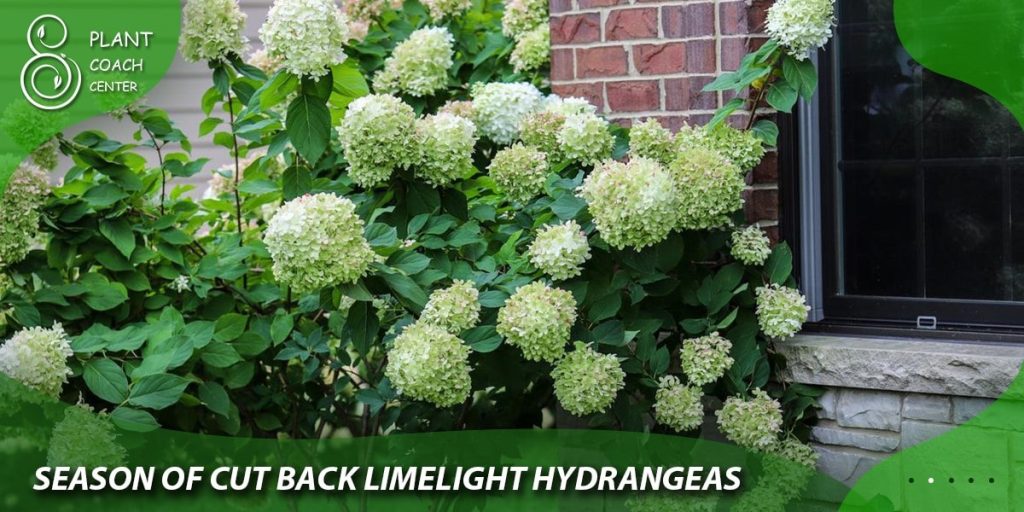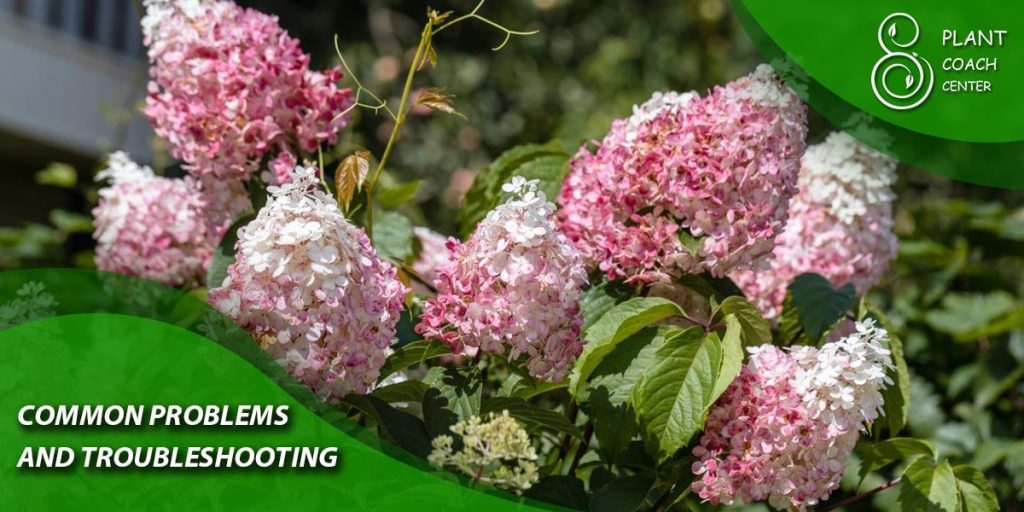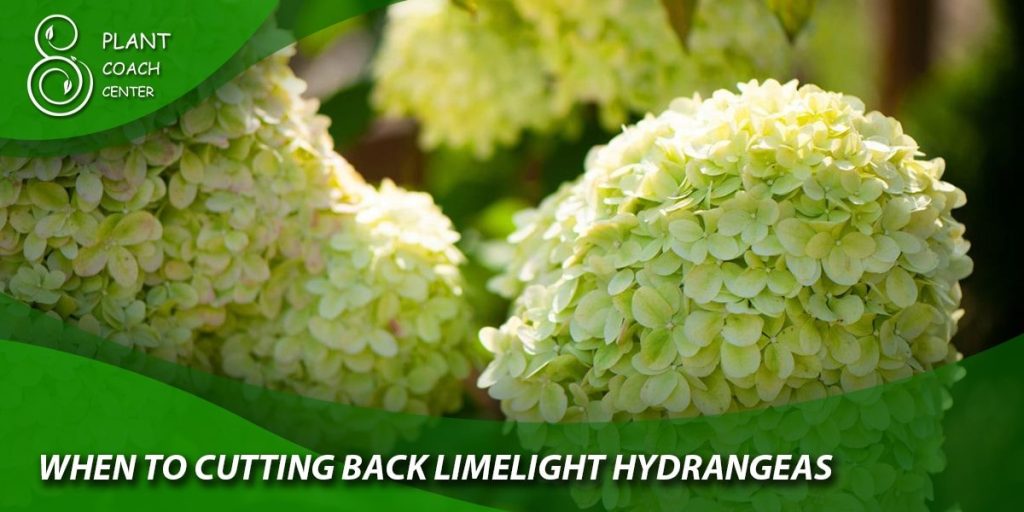When to Cut Back Limelight Hydrangea
Limelight hydrangeas (Hydrangea paniculata ‘Limelight’) are popular flowering shrubs known for their stunning display of vibrant, cone-shaped blooms. These hydrangeas add a refreshing touch to any garden or landscape with their distinctive lime-green color.
Proper care and maintenance are crucial for ensuring healthy growth and abundant blooms. One essential aspect of caring for Limelight hydrangeas is knowing when to cut them back. This comprehensive guide will explore the optimal pruning time for Limelight hydrangeas and provide step-by-step instructions to help you maintain these beautiful plants.

Understanding Limelight Hydrangeas
Before we delve into the timing of pruning, let’s take a closer look at Limelight hydrangeas and their growth habits. Limelight hydrangeas are deciduous shrubs that belong to the Hydrangea paniculata species. They are characterized by their large, ovate leaves and showy panicles of flowers that emerge in mid-summer. Unlike other hydrangea varieties, Limelight hydrangeas bloom on new wood, producing flowers in the current season’s growth.
Limelight hydrangeas typically reach a height and spread of 6 to 8 feet (1.8 to 2.4 meters) and have a compact, rounded form. Their flowers start as pale green buds and gradually turn creamy white, maturing to shades of pink as the season progresses. These blossoms are long-lasting, often remaining on the shrub until late autumn, providing visual interest well into the fall.
Factors Affecting Growth and Flowering
Several factors can influence the growth and flowering of Limelight hydrangeas. These include sunlight exposure, soil conditions, and climate. Limelight hydrangeas thrive in full sun to partial shade, requiring at least six hours of direct sunlight daily for optimal growth and blooming. These hydrangeas may produce fewer flowers or exhibit stretched growth patterns when planted in overly shaded areas.
Limelight hydrangeas prefer well-draining, fertile soil with a slightly acidic to neutral pH level. Adequate moisture is essential, as these plants are not drought-tolerant. Proper air circulation around the shrubs also helps prevent diseases and promotes healthy growth.
Understanding these basic characteristics and requirements of Limelight hydrangeas sets the foundation for effectively pruning and caring for these plants. Now let’s explore the benefits of pruning and why it is essential for the health and vitality of your Limelight hydrangeas.
Benefits of Pruning Limelight Hydrangeas
Promoting Health and Vigor
Proper pruning plays a vital role in promoting the overall health and vigor of Limelight hydrangeas. Removing dead, damaged, or diseased wood helps eliminate potential entry points for pests and diseases. Pruning also encourages the growth of new shoots. It improves air circulation throughout the plant, reducing the risk of fungal infections.
Enhancing Flower Production
One of the primary reasons gardeners prune Limelight hydrangeas is to enhance flower production. By selectively removing old, spent blooms and thinning out the branches, you stimulate the development of new growth and encourage the formation of larger, more abundant flower clusters. Pruning also helps maintain a compact and manageable shape, ensuring the shrub produces beautiful blooms yearly.
Shaping and Controlling Growth
Limelight hydrangeas naturally grow vigorously, often resulting in a dense and sprawling appearance. Pruning allows you to shape and control the growth of these shrubs, creating a more aesthetically pleasing form. Whether you prefer a rounded shape, a more structured hedge, or even a small tree-like form, regular pruning enables you to sculpt your Limelight hydrangeas according to your desired vision.
Furthermore, proper pruning can help address specific growth issues, such as overgrown or leggy branches. You can promote a fuller and more balanced shrub by selectively removing excessive growth and encouraging branching lower down on the stems.
Now that we understand the importance of pruning Limelight hydrangeas let’s explore the optimal time for pruning.

When to Prune Limelight Hydrangeas
Pruning in Spring
The spring season offers an ideal window for pruning Limelight hydrangeas. Timing is crucial, as pruning too early in spring can remove flower buds and diminish the blooming potential for the current season. Aim to prune your Limelight hydrangeas in late winter or early spring, just before new growth emerges.
During the late winter dormancy period, Limelight hydrangeas reveal their branching structure, making identifying dead or damaged wood easier. As the buds swell and show signs of breaking dormancy, it’s time to grab your pruners and get to work.
When pruning in spring, focus on removing any dead or weak branches, as well as any crossing or rubbing stems. Thin out the shrub’s interior to improve airflow and reduce disease risk. Avoid excessive pruning, which can lead to fewer flowers or delayed blooming.
Pruning in Fall
Pruning Limelight hydrangeas in the fall is another viable option but requires careful consideration. Fall pruning is best suited for situations where the shrub has become overgrown or needs significant rejuvenation. It allows you to reduce the size of the plant and reshape it before the onset of winter.
Timing is critical when pruning in the fall. It’s crucial to allow enough time for the shrub to recover before the first frost arrives. Aim to prune Limelight hydrangeas in late summer or early fall, typically around September. This timing provides ample time for the shrub to recover, set buds for the following year, and withstand the winter months.
When pruning in the fall, focus on removing any dead or diseased wood and thinning out excessive growth. Be cautious not to remove too much, as this can hinder the plant’s ability to recover and produce flowers in the following season.
Pruning During the Blooming Season
In addition to the major pruning sessions in spring and fall, Limelight hydrangeas can benefit from maintenance pruning during the blooming season. This pruning involves deadheading, which removes spent blooms to encourage continuous flower production.
To deadhead Limelight hydrangeas:
- Wait until the flowers have faded and begun to dry out on the shrub.
- Use pruning shears or scissors to cut the faded blooms just above a set of healthy leaves or leaf nodes.
- Removing the spent flowers redirects the plant’s energy toward producing new growth and additional blooms.

Step-by-Step Guide to Pruning Limelight Hydrangeas
Tools and Equipment
Before pruning your Limelight hydrangeas, gather the necessary tools and equipment to ensure a successful pruning session. Here are the items you’ll need:
- Pruning shears or hand pruners: These will be your go-to tools for most tasks, such as removing deadwood, thinning branches, and deadheading blooms.
- Loppers: Use loppers for thicker branches that are beyond the capacity of pruning shears. They provide extra leverage and cutting power.
- Gloves: Wear protective gloves to safeguard your hands from thorns, rough stems, and potential irritants.
- Disinfectant: Prepare a solution of disinfectant or rubbing alcohol to sterilize your cutting tools between each pruning cut. This helps prevent the spread of diseases from one plant to another.
Preparing for Pruning
Once you have your tools ready, it’s time to prepare your Limelight hydrangeas for pruning. Follow these steps before you begin:
- Assess the plant: Take a close look at your Limelight hydrangeas and identify any dead, damaged, or diseased wood. This will guide you in knowing what to remove during the pruning process.
- Remove debris: Clear away any fallen leaves, twigs, or other debris around the base of the shrub. This ensures a clean working area and minimizes the risk of introducing pests or diseases.
- Water the plant: Hydrangeas prefer pruning when the soil is moist but not overly saturated. Water the shrub a day or two before you plan to prune, allowing the soil to drain adequately.
Techniques for Pruning Different Growth Types
Limelight hydrangeas can exhibit different growth habits, such as shrub or tree forms. Understanding these growth types will help you employ the appropriate pruning techniques for optimal results.
- Shrub Form:
- Removing deadwood: Remove any dead, dry, or diseased branches. Make clean cuts by positioning your pruning shears above a healthy bud or leaf set.
- Thinning out branches: Identity crowded or crossing branches within the shrub. Thin out the plant’s interior by selectively removing some branches, allowing for improved airflow and light penetration.
- Reducing height and size: If your Limelight hydrangea has grown too large or become overgrown, selectively prune branches by cutting them back to a desired height. Make the cuts just above a set of healthy leaves or buds, ensuring a neat and natural appearance.
- Tree Form:
- Removing lower suckers: Limelight hydrangeas can be trained into a small tree-like form by removing lower suckers and allowing a single trunk to develop. Locate any suckers growing from the base of the plant and prune them off at ground level.
- Selective thinning: As with the shrub form, identify any dead, damaged, or diseased wood and remove it. Additionally, thin out crowded or crossing branches within the canopy to maintain an open and balanced structure.
- Crown maintenance: Maintain the desired height and shape of the tree form by selectively pruning branches. Trim back any excessively long or wayward branches to encourage a compact and well-proportioned crown.
Remember to step back frequently while pruning to assess the overall shape and symmetry of your Limelight hydrangeas. Take your time and make precise cuts to ensure the best possible outcome.

Common Problems and Troubleshooting
Disease and Pest Management
While Limelight hydrangeas are generally hardy plants, they can still be susceptible to certain diseases and pests. Here are some common issues you may encounter and steps you can take to manage them:
- Powdery mildew: This fungal disease appears as a white powdery coating on the leaves stems, and flowers. To manage powdery mildew, ensure proper air circulation around the plant by thinning out dense growth. Additionally, avoid overhead watering and apply fungicides as directed if necessary.
- Leaf spot diseases: Leaf spot diseases manifest as dark spots or imperfections on the leaves. To prevent leaf spots, provide adequate spacing between plants for good airflow, avoid overhead watering, and promptly remove any infected leaves.
- Aphids: These small, soft-bodied insects feed on plant sap and can cause distorted growth or yellowing of leaves. Control aphids by spraying a strong stream of water on the affected plant parts or using insecticidal soap or horticultural oil if infestations are severe.
- Japanese beetles feed on foliage, causing skeletonized leaves. Handpick them off the plants in the early morning when they are less active, or use pheromone traps to lure and capture them.
Overgrown and Leggy Plants
Suppose your Limelight hydrangeas have become overgrown or leggy. In that case, there are steps you can take to rejuvenate them and restore their shape:
- Renewal pruning: In late winter or early spring, perform renewal pruning to rejuvenate an overgrown shrub. Cut back one-third of the oldest; woodiest stems to ground level. This stimulates new growth and helps maintain a more compact form.
- Heading back: To reduce leggy growth and encourage branching, selectively cut back long, bare stems to a set of healthy leaves or buds. This encourages the development of new shoots lower on the plant.
Non-Flowering or Poor Blooming
If your Limelight hydrangeas aren’t producing abundant blooms, consider the following factors:
- Insufficient sunlight: Limelight hydrangeas require at least six hours of direct sunlight each day to promote robust flowering. If they are planted in overly shaded areas, consider transplanting them to a sunnier location.
- Improper pruning: Pruning at the wrong time or excessive pruning can remove flower buds and reduce blooming. Ensure you prune your Limelight hydrangeas at the appropriate times outlined earlier in this article, and avoid over-pruning.
- Nutrient deficiencies: A lack of essential nutrients, particularly phosphorus, can inhibit flower production. Conduct a soil test to determine any nutrient deficiencies and amend the soil accordingly.
- Environmental stress: Extreme heat, drought, or other environmental stressors can affect blooming. Provide consistent moisture, especially during dry spells, and ensure your plants are adequately watered.
Addressing these common problems and troubleshooting techniques can help your Limelight hydrangeas thrive and achieve their full blooming potential.
Additional Tips and Considerations
Fertilization and Soil Amendments
Proper fertilization is crucial for the healthy growth and blooming of Limelight hydrangeas. Consider the following tips:
- Soil testing: Conduct a soil test to determine your soil’s pH and nutrient levels. Limelight hydrangeas prefer a slightly acidic to neutral pH range (around 6.0 to 7.0). You can adjust the pH and supplement any nutrient deficiencies with appropriate amendments based on the soil test results.
- Organic matter: Incorporate organic matter into the soil, such as compost or well-rotted manure. This improves soil structure, enhances moisture retention, and provides a slow release of nutrients.
- Balanced fertilizers: Apply a balanced slow-release fertilizer for woody shrubs or hydrangeas in early spring. Follow the manufacturer’s instructions for proper application rates. Avoid excessive fertilization, as it can lead to excessive vegetative growth at the expense of blooms.
Mulching and Watering Practices
Proper mulching and watering practices help maintain moisture levels and protect the roots of your Limelight hydrangeas. Consider the following guidelines:
- Mulching: Apply a layer of organic mulch, such as wood chips or shredded bark, around the base of the shrub. This helps suppress weeds, retain moisture, and regulate soil temperature. Keep the mulch a few inches away from the base of the stems to prevent excess moisture accumulation and potential rot.
- Watering: Limelight hydrangeas prefer consistently moist but well-draining soil. Water deeply and thoroughly, ensuring the root zone is adequately saturated. Aim for slow, deep watering rather than frequent shallow watering. Monitor the moisture levels regularly and adjust watering frequency based on weather conditions.
- Drip irrigation or soaker hoses: Consider using drip irrigation or soaker hoses to deliver water directly to the root zone. This helps minimize water loss due to evaporation and reduces the risk of fungal diseases by keeping the foliage dry.
Winter Protection Measures
Protecting your Limelight hydrangeas during winter ensures their survival and promotes healthy growth in the following season. Here are some winter protection measures to consider:
- Mulching: Apply a thick layer of mulch around the base of the shrub, extending it out to the drip line. This helps insulate the roots and protect them from extreme temperature fluctuations.
- Windbreaks: If your region experiences strong winter winds, consider erecting a windbreak using burlap or other suitable materials. This shields the shrub from desiccating winds and prevents damage to branches.
- Snow protection: If heavy snowfall is common in your area, gently brush off excess snow from the branches to prevent breakage. Avoid shaking or forcefully removing snow, as this can cause more harm than good.
By following these additional tips and considerations, you can provide optimal care for your Limelight hydrangeas throughout the year, ensuring their health, vitality, and stunning blooms.

Conclusion
Pruning Limelight hydrangeas at the right time and using proper techniques is essential for maintaining their health, promoting vigorous growth, and enhancing their stunning blooming display. By understanding the growth habits of Limelight hydrangeas and following the guidelines outlined in this comprehensive guide, you can confidently prune your plants to achieve optimal results.
Remember to assess the specific needs of your Limelight hydrangeas, considering factors such as sunlight exposure, soil conditions, and climate. Tailor your pruning practices accordingly to ensure the best outcomes for your plants.
Regular pruning keeps your Limelight hydrangeas in shape and encourages flower production, controls growth, and helps address common problems. Be sure to follow the recommended pruning times, either in spring or fall, depending on your specific goals and the condition of the shrub. Additionally, maintenance pruning during the blooming season, such as deadheading, can prolong the flowering period and promote continuous blooms.
As you embark on your pruning journey, be patient and take your time. Step back frequently to assess the overall shape and symmetry of your Limelight hydrangeas, making precise cuts to maintain their natural beauty.
In addition to pruning, don’t forget other important aspects of caring for Limelight hydrangeas, such as proper fertilization, mulching, watering, and winter protection measures. By providing comprehensive care, you can ensure that your Limelight hydrangeas thrive and reward you with their spectacular blooms year after year.
Enjoy the process of pruning and nurturing your Limelight hydrangeas, and savor the beauty they bring to your garden or landscape. With proper care and attention, these magnificent plants will continue to enchant and captivate with their vibrant and alluring presence.
Can Limelight hydrangeas be pruned in summer?
Light maintenance pruning is acceptable, but avoid significant pruning in summer.
How much should I prune Limelight hydrangeas?
Prune no more than one-third of the plant's overall growth.
What if I accidentally prune too much?
The plant will recover over time; ensure proper care for new growth and blooming in subsequent seasons.







